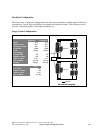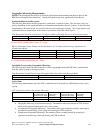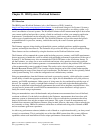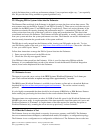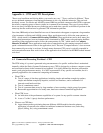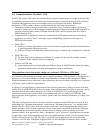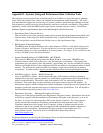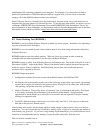
CPW Application Description
The CPW application simulates the database server of an online transaction processing (OLTP)
environment. Requests for transactions are received from an outside source and are processed by
application service jobs on the database server. It is based, in part, on the business model from
benchmarks owned and managed by the Transaction Processing Performance Council. However, there are
substantive differences between this workload and public benchmarks that preclude drawing any
correlation between them. For more information on public benchmarks from the Transaction Processing
Performance Council, refer to their web page at www.tpc.org.
Specific choices were made in creating CPW to try to best represent the relative positioning of iSeries and
AS/400 systems. Some of the differences between CPW and public benchmarks are:
y The code base for public benchmarks is constantly changing to try to obtain the best possible results,
while an attempt is made to keep the base for CPW as constant as possible to better represent relative
improvements from release to release and system to system.
y Public benchmarks typically do not require full security, but since IBM customers tend to run on
secure systems, Security Level 50 is specified for the CPW workload
y Public benchmarks are super-tuned to obtain the best possible results for that specific benchmark,
whereas for CPW we tend to use more of the system defaults to better represent the way the system is
shipped to our customers.
y Public benchmarks can use different applications for different sized systems and take advantage of all
of the resources available on a particular system, while CPW has been designed to run as the same
application at all levels with approximately the same disk and memory resources per simulated user
on all systems
y Public benchmarks tend to stress extreme levels of scaling at very high CPU utilizations for very
limited applications. To avoid misrepresenting the capacity of larger systems, CPW is measured at
approximately 70% CPU utilization.
y Public benchmarks require extensive, sophisticated driver and middle tier configurations. In order to
simplify the environment and add a small computational component into the workload, CPW is
driven by a batch driver that is included as a part of the overall workload.
The net result is an application that IBM believes provides an excellent indicator of transaction processing
performance capacity when comparing between members of the iSeries and AS/400 families. As
indicated above, CPW is not intended to be a guarantee of performance, but can be viewed as a good
indicator.
The CPW application simulates the database server of an online transaction processing (OLTP)
environment. There are five business functions of varying complexity that are simulated. These
transactions are all executed by batch server jobs, although they could easily represent the type of
transactions that might be done interactively in a customer environment. Each of the transactions interacts
with 3-8 of the 9 database files that are defined for the workload. Database functions and file sizes vary.
Functions exercised are single and multiple row retrieval, single and multiple row insert, single row
update, single row delete, journal, and commitment control. These operations are executed against files
that vary from 100's of rows to 100's of millions of rows. Some files have multiple indexes, some only
one. Some accesses are to the actual data and some take advantage of advanced functions such as
index-only access.
IBM i 6.1 Performance Capabilities Reference - January/April/October 2008
© Copyright IBM Corp. 2008 Appendix A - CPW and CIW Descriptions 337




